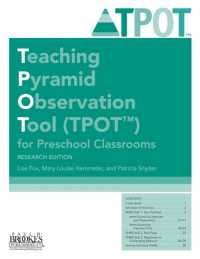Full Description
Make data work for your school—and for every student
Far too often, educators are inundated with data that feels overwhelming, irrelevant, or unhelpful. In Using Data to Improve Schools, nationally recognized expert on school transformation and student achievement Elaine Allensworth offers a framework for understanding the critical properties of data and the tools educators need to focus on the metrics that matter most for student achievement. Rooted in two decades of research on educational policy and practice and real-world success stories from Chicago Public Schools, this groundbreaking guide bridges the gap between theory and practice, helping educators build a culture of data-driven collaboration and success. Topics covered include
Common myths and assumptions that divert attention from the data that matter most
Guidance on using systems for continuous improvement such as Early Warning Indicator (EWI) and Multi-Tiered Systems of Support (MTSS)
Tools to align teachers, families, and staff around a shared vision and strategies that build trust and momentum for sustainable growth
Allensworth clearly outlines how schools can improve key performance areas—like attendance, test scores, and graduation rates—by identifying high-impact metrics and fostering a collaborative culture of improvement. By simplifying complex concepts and offering tools for effective collaboration, this guide inspires educators to turn numbers into positive change.
Contents
ACKNOWLEDGMENTS
ABOUT THE AUTHOR
INTRODUCTION
CHAPTER 1: DESIGNING THE SCHOOL TO REACH YOUR VISION
Results With the Right Data
Focusing on the Wrong Metrics
Improvement Requires Change
What Is Evidence-Informed Practice in Education?
Data Are the Starting Point to Productive Conversations
What the Data Represent Is Most Important
Data for Accountability Versus Improvement
Using Data to Support Success, Not Add Burden
Key Takeaways
Reflection Questions
CHAPTER 2: SIX KEY PROPERTIES OF DATA
Data Are Messy: Reliability and Validity Show Trustworthiness
Properties That Make Data Useful for School Improvement
How to Get Data on the Properties of Data
Key Takeaways
Reflection Questions
CHAPTER 3: DATA ON STUDENT LEARNING
Standardized Test Scores
Course Grades and GPAs
Key Takeaways
Reflection Questions
CHAPTER 4: USEFUL DATA FOR STUDENT ENGAGEMENT AND EXPERIENCES IN SCHOOL
Data on Student Engagement and Experiences
Attendance
Student and Teacher Survey Data
Classroom Observations
Opportunity Structures
Key Takeaways
Reflection Questions
CHAPTER 5: MAKING USE OF DATA: VISION AND GOALS
Shared Leadership and Alignment
A Compelling Vision
Setting Goals
Key Takeaway
Reflection Questions
CHAPTER 6: MAKING USE OF DATA: CONTINUAL IMPROVEMENT
Building the Conditions for Student Success: School-Wide and Tier 1 Strategies
Supporting Struggling Students: EWI Systems and Tier 2 and 3 Interventions
Evaluating Instructional and Program Effectiveness
Communication Across the School Community
Key Takeaways
Reflection Questions
CONCLUSION: WHICH DATA FOR WHAT PURPOSE?
REFERENCES
INDEX



![BaSiK U3 [10 Bögen] : Begleitende alltagsintegrierte Sprachentwicklungsbeobachtung in Kindertageseinrichtungen. Version für Kinder im Alter von 1,0 bis 3,5 Jahren. 10 Beobachtungsbögen (3. Auflage. 2019. 24 S. 15 Abb. 297.00 mm)](../images/goods/ar/work/imgdatak/34513/3451384434.jpg)




